The convict cichlid (lat. Amatitlania nigrofasciata) is one of the smallest and the least demanding Central American cichlids. Despite its small size, it has a quarrelsome and rough temper, so the task of selecting proper tank mates for it is a challenging one. Further in the article, you will find out where convict cichlid inhabits, how large it can grow, how to keep it in the tank, feed, and breed.
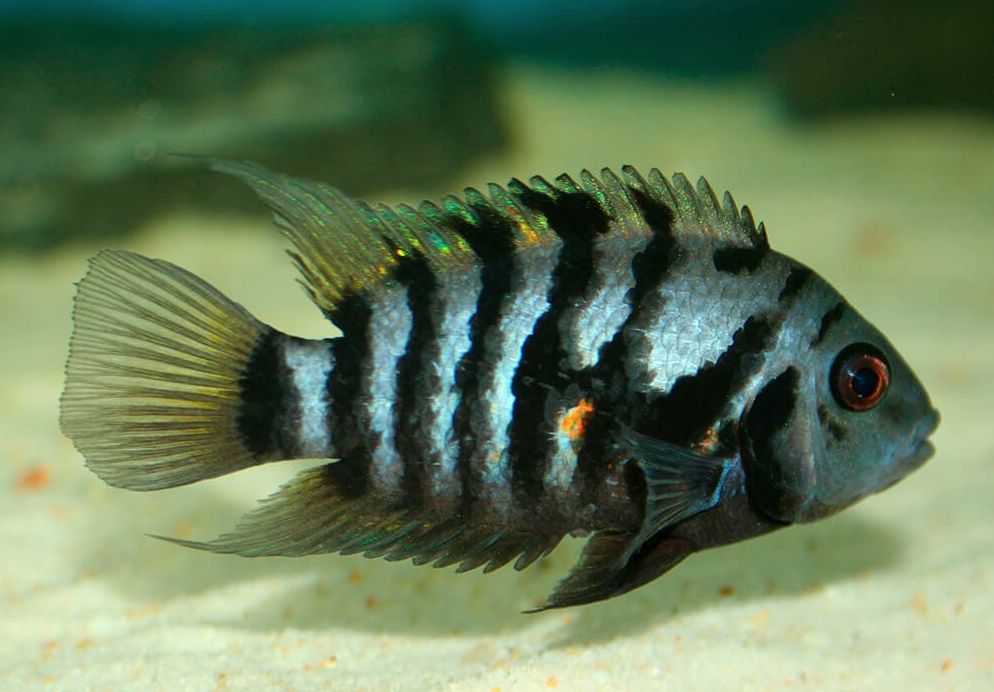
Contents
Habitat in the wild
Their native range extends across Central America, with specific populations found in different countries within the region. The convict cichlid is native to Central America: Guatemala, Panama, Costa-Rica, Nicaragua, Honduras. The most known fish habitats are high altitude lakes of volcanic origin— Atitlán and Amatitlán on Guatemalan Highlands.
Convict Cichlids have become invasive species in several regions outside their native range, primarily due to their adaptable nature, aggressive behavior, and prolific breeding. The ones that got into local ponds from tanks have created a stable population in Australia and North America. Convict Cichlids have been reported in several states across the southern and southwestern regions of the United States. Some of the states where they have established populations include Texas, Florida, California, Arizona, and Louisiana. Convict Cichlids are considered invasive species in the United States. In their introduced range, they can negatively impact native fish populations through competition for resources and predation on smaller species. Their aggressive behavior and high reproductive rate allow them to quickly establish and expand populations.
A typical fish biotope is a pond with rocky bottom. Its representatives are seldom encountered in open waters since they prefer waters with many shelters. They are versatile and can adapt to various water conditions.
After the revision in 2007, systematizers separated convict cichlid together with three newly described similar kinds into a standalone genus that received the name Amatitlania nigrofasciata, which didn’t last long.
Nowadays, the name of the fish kind is Amatitlania nigrofasciata. Most spread synonyms existing for this species include Archocentrus nigrofasciatum, Archocentrus nigrofasciatus, Cichlasoma nigrofasciatum, Cryptoheros nigrofasciatus, Heros nigrofasciatus.
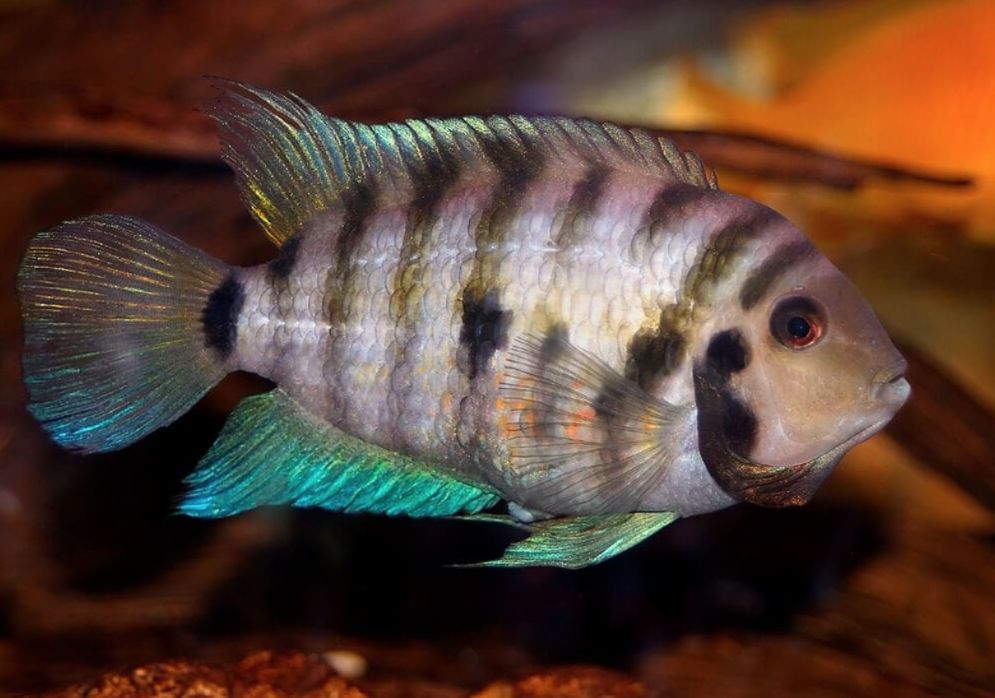
Description
Body
Convict cichlids have a compact and robust body shape. They have an oval-shaped body that is slightly elongated, especially in males. The eyes of Convict Cichlids are typically dark or black in color.
Color
The coloration of Convict Cichlids varies depending on their gender and mood. Males typically have a striking color pattern with vertical black stripes running along their silver-white or gray body. These stripes may appear more pronounced during breeding or when the male is displaying aggression. The fish body has about 8-9 vertical dark stripes on it, due to which the fish has got its name. Its coloring intensity may vary. At that, the stripes right under the gill cover have abruption and resemble Latin «U.»
The fins are transparent with a slightly greenish tint. Males tend to have more elongated and pointed fins compared to females.
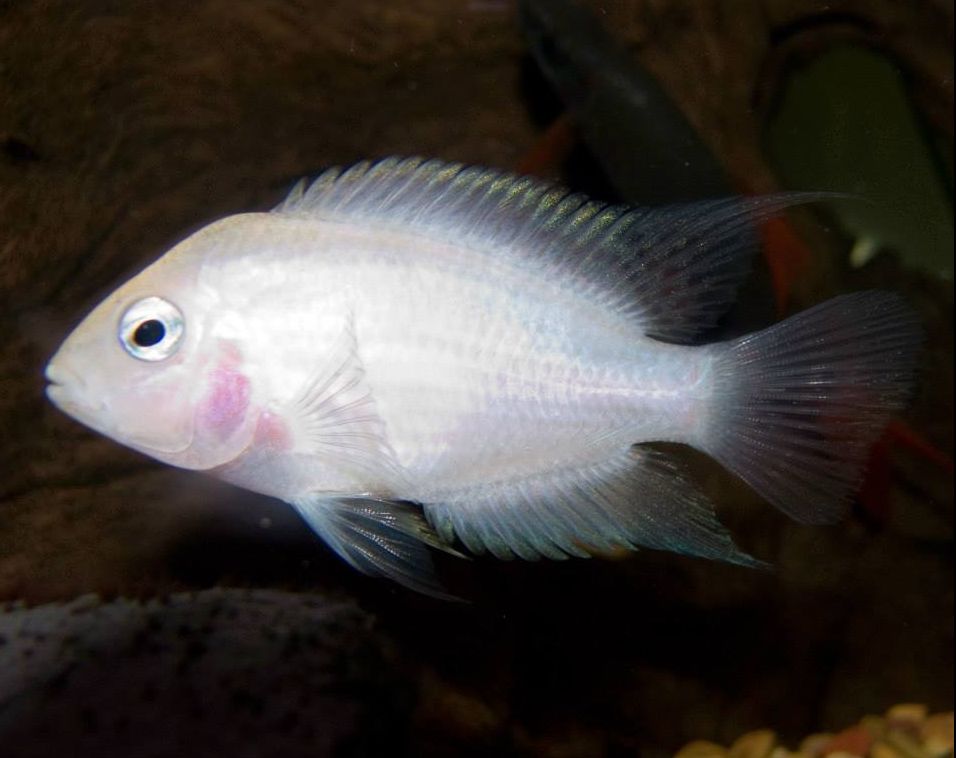
Exist a color variant or morph of the Convict Cichlid (Amatitlania nigrofasciata) that exhibits a pink or reddish coloration. This color variation is not a naturally occurring trait in convict cichlids, but rather a result of selective breeding and genetic mutations within the captive fish population.
Pink convict cichlids are the product of selective breeding for specific color traits, and they can display a range of pink or reddish hues. The intensity of the pink coloration can vary among individuals, and some may exhibit a more vibrant pink coloration than others.
It’s important to note that the pink coloration is a result of artificial selection and does not occur in wild populations of convict cichlids. These color morphs are popular in the aquarium trade and are bred for their unique and eye-catching appearance. However, it’s essential to ensure that the care requirements for pink convict cichlids are the same as for their wild-type counterparts to maintain their health and well-being in captivity.

The Marble Convict Cichlid is a color morph or variation of the Convict Cichlid that exhibits a marbled or mottled pattern on its body. This variation is a result of selective breeding within the aquarium hobby, and it is not a naturally occurring coloration in the wild.
The Marble Convict Cichlid typically displays a mix of different colors, such as black, white, gray, and sometimes hints of yellow or orange. The pattern resembles marble or swirling patterns, giving it a unique and attractive appearance. The exact pattern and coloration can vary between individuals, making each Marble Convict Cichlid somewhat unique in its appearance.
Size
How big do convict cichlids get?
Convict Cichlids (Amatitlania nigrofasciata) exhibit sexual dimorphism, meaning there are differences in size between males and females. Here’s an overview of the typical size range for Convict Cichlids:
- Male Size: Adult male can reach a size of about 4 to 6 inches (10 to 15 cm) in length, measuring from the tip of their snout to the end of their caudal fin (tail). Males are generally larger than females and have a more elongated body shape.
- Female Size: Adult female tend to be slightly smaller than males, typically reaching a size of around 3 to 4 inches (7 to 10 cm) in length. They have a rounder body shape compared to males.
Lifespan
How long do convict cichlids live?
Convict Cichlids have an average lifespan of around 5 to 8 years in captivity. However, with proper care, some individuals have been known to live up to 10 years or even slightly longer. It’s important to note that the lifespan of Convict Cichlids can be influenced by various factors, including genetics, water quality, diet, tank size, and overall care. Providing a suitable environment, balanced diet, regular maintenance, and monitoring their health can contribute to maximizing their lifespan.
Growth rate
How fast do convict cichlids grow?
Convict cichlids have a moderate growth rate compared to some other cichlid species. The growth rate of convict cichlids can be influenced by various factors, including genetics, water quality, diet, and overall care provided.
On average, convict cichlids can reach a size of around 1 to 2 inches (2.5 to 5 cm) within the first few months of their lives. During the first year, they can grow to a size of about 3 to 4 inches (7 to 10 cm) in length. It’s important to note that these growth rates are approximate and individual growth can vary.
The growth rate of convict cichlids can slow down as they approach maturity. After reaching their adult size, growth becomes more gradual, and the focus shifts more towards maintenance and overall health rather than rapid growth.
You may often encounter fconvict cichlid – its body is pinkish and yellow, the eyes are dark-colored, but breeding and keeping are quite the same as for a classical species. Since the fish is easy to breed, there are many other color variations, for example, blue, green, or even gold.
| Characteristic | Description |
|---|---|
| Scientific Name | Amatitlania nigrofasciata |
| Common Name | Convict Cichlid, convict fish, |
| Native Range | Central America (Nicaragua, Honduras, Costa Rica, Guatemala) |
| Size | Up to 6 inches (15 cm) for males, slightly smaller for females |
| Lifespan | Average lifespan of 5-8 years |
| Aggression | Highly aggressive, especially during breeding and defending territory |
| Coloration | Males: Vertical black stripes on a silver-white or gray body; Females: Less prominent stripes or solid coloration |
| Body Shape | Compact and robust |
| Sexual Dimorphism | Males are larger and more brightly colored than females |
| Breeding Behavior | Monogamous pairs, construct nests, and both parents care for eggs and fry |
| Habitat | Freshwater rivers, streams, lakes, and ponds |
| Diet | Omnivorous, feeding on insects, small crustaceans, plant matter, and detritus |
| Preferred Water pH | 6.5-7.5 |
| Preferred Water Temperature | 75-82°F (24-28°C) |
| Compatibility | Can be aggressive towards other fish; choose tank mates carefully |
| Common Invasive Species | Established populations in certain regions of the United States |
| Conservation Status | Not evaluated |
Difficulties in keeping
Zebra convict is very easy to keep and care for. It is undemanding.
However, it is a good pet only for aquarists who have experience in keeping cichlids. It has an intriguing appearance, ad, as many aquarists say, it is smart. If you don’t plan to breed convict fish, it is recommended to have just one species in a tank, to avoid spawning aggression. Otherwise, it is not a difficult task. The fish is fruitful, and it is not challenging to create tank conditions maximally close to those in the wild.
At the same time, this is definitely not the fish for beginners due to its quarrelsome temper and the habit of digging the tank bottom. It’s better to keep the fish alone or with other Central American cichlid species in a very spacious tank.
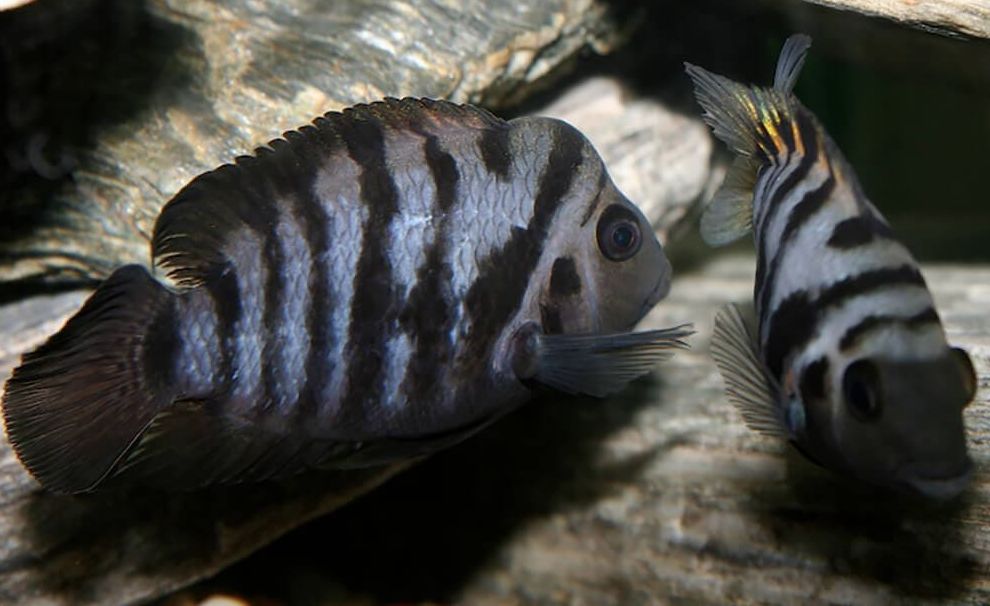
Care and keeping in a tank
Tank size
How many convict cichlids can be in a tank?
The optimal number is a couple of fish. The most important thing to keep in mind when keeping convict cichlids is their strong territory dependence. Convict cichlids are known to be territorial and aggressive, especially during breeding and when defending their nests. The conclusion you can make based on this is about minimal tank size for the fish and peculiarities of its decoration.
A couple of young fish can live in a tank of 100 liters capacity (26 gallons), but reproductive adult fish require about 250 liters (55 gallons) capacity tank. However, if you’re planning to keep multiple Convict Cichlids together, it’s essential to provide ample space to reduce aggression and minimize stress.
It’s desirable to keep zebra convict in large capacity tanks and open spaces for the fish to swim. For a larger community setup, a tank size of at least 110 gallons (416 liters) or more is recommended to accommodate multiple convict cichlids. In such cases, it’s advisable to create sufficient hiding spots, provide ample territory boundaries, and introduce compatible tank mates to help distribute aggression and reduce potential conflicts.
It’s crucial to closely monitor the behavior of the convict cichlids when keeping them in a group. If aggression becomes a significant issue, it may be necessary to rehome or separate certain individuals to ensure the well-being of the fish.
Pay attention that, first of all, we mean community tanks, where other fish kinds will dwell as well. If you plan to have a species tank, a tank of smaller capacity will do.
Water parameters
Convict cichlids can live under various parameters of water acidity and hardness. However, tank water should have a pH of about 6.5–7.5 and a hardness of 6 — 20 dGH.
In the wild, the fish dwells at rather a wide temperature range. On the day, the air temperature is about 26–29 °C (79–84°F), while at night, it essentially decreases. This allows them to dwell in volcanic lakes at about 1,500 meters (4,900 ft) high. If the temperature in the room with a tank doesn’t get lower than 21°C (69,8°F), you won’t need a heater.
Tank setup: decorations and plants
This isn’t a demanding fish, and it’s easy to care about. You must pay close attention to the tank interior, especially if there are other species in the tank. Some large-grained bottom substrate, snags, roots, stones make the fish feel comfortable.
Each Convict cichlid couple must have its own shelter in the tank with natural borders. If you skip this point, you’ll constantly have fights in the tank. Territory zoning is also possible by putting tank plants, but these should be some tolerant and strong ones since the fish often digs tank bottom substrate and moves it, so some small and tender plants may be dug out completely.
For the same reason, we don’t recommend using sand as a bottom substrate, but some small- or medium-sized substrate will do. At that, tank plants must be surrounded with large stones to prevent them from being dug out by the fish.
Tank lighting must suit the tank plants’ needs since these cichlids don’t care much about it.
Filtration
The tank requires filtration, aeration, and weekly water renews of about 1/3 of the tank volume. It’s highly recommended to use a rather powerful canister filter since the fish likes digging tank bottom.
Diet
The wild species feed on various insects and their larvae, worms, fish juveniles, aquatic vegetation.
Convict cichlid is omnivorous, i.e., it eats everything you give. You may feed it with different food: for example, some artificial feed for cichlids, some tablets and flakes with spirulina, blood worm, tubifex, brine shrimp. To prevent tank pollution with feed leftovers, feed the fish twice a day with small food portions.
However, you must remember that live food is dangerous because of possible bacterial and fungus infection and parasite worms and protozoaires. Also, don’t forget that in case of overfeeding, such food will quickly and significantly decrease tank water parameters.
Artificial food is completely viceless compared with the latter two. Thus it is the best choice for the fish diet. Several times a week, you should add some food with high spirulina content to it. Eating plant food is crucial for the proper function of convict cichlids’ digestive system.
Keep in mind that the fish tends to overeat, so it is better to feed it once or twice a day in small portions.
Tank mates
When keeping convict cichlids together with other fishes, there may be two situations.
The first situation when the coinhabitance is peaceful and trouble free, and the second one, when they demonstrate aggression towards their tank mates. The problems arise either during the spawning period or when other fishes intrude on their territory. When protecting it, convict cichlids fearlessly attack anyone, even unequal rivals.
In small tanks, it is recommended to keep a couple of convict cichlids. These species become very aggressive during the spawning period and any other time – it may attack other fishes. You must ensure that each male has at least one male.
Cichlids of equal size will be the best tank mates in this case: firemouth cichlid, blood parrot, kribensis, angelfish. While they won’t be able to live with African cichlids (like mbuna) since both species are territory dependent, and they fight till death for their shelters.
They get on well with active fishes that dwell in middle water layers: tiger barbs, swordtails, bala sharks. However, various bottom-dwelling species (clown loach, panda cory, pictus catfish, bristlenose pleco) are not always compatible with convict cichlids. This is because cichlids lay their eggs near the bottom, and the fishes constantly swimming near the bottom will often invade their territory and provoke fights.
Small-sized fish species (guppies, neon tetras, betta, goldfish) are very likely to become convict cichlids’ live food. In contrast, large cichlids (jack dempsey cichlid, oscar, flowerhorn, red terror cichlid) may kill convict cichlids themselves and aren’t good tank mates for them too.
That’s why even in a spacious tank, you should choose strong and proper-sized convict cichlid tank mates.
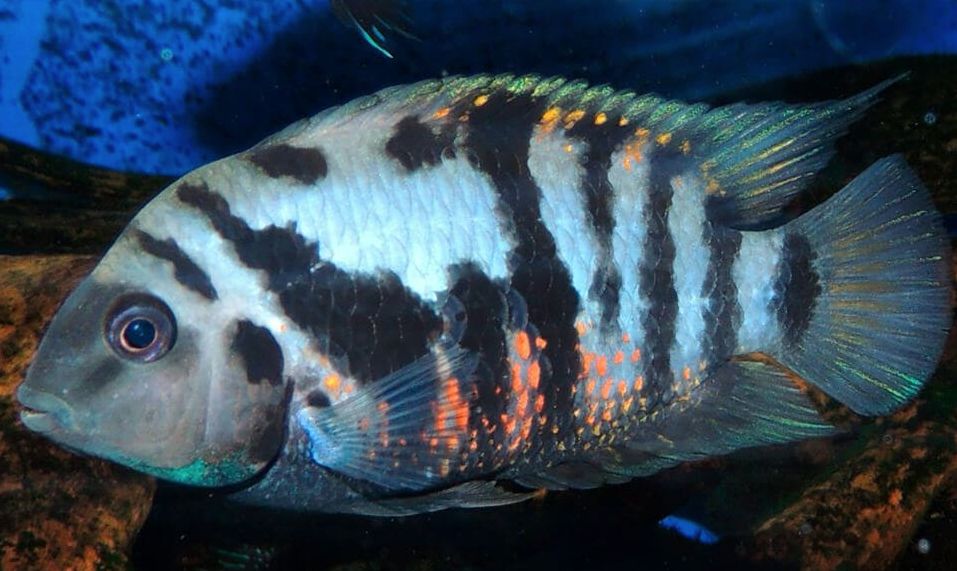
Gender differences: male vs female
There are several noticeable differences between male and female convict cichlids in terms of their physical appearance and behavior. Here are some key distinctions:
- Size: Males tend to be larger than females. Adult males can grow up to 4 to 6 inches (10 to 15 cm) in length, while females are slightly smaller, typically reaching about 3 to 4 inches (7 to 10 cm) in length.
- Body Shape: Males have a more elongated and streamlined body shape compared to females, which have a rounder and plumper appearance. Older males frequently develop vestigial fatty lumps on their foreheads.
- Coloration: Male Convict Cichlids often exhibit more vibrant and striking coloration than females. They display vertical black stripes on a silver-white or gray body, and the intensity of these stripes can vary depending on their mood, breeding status, and aggression level. In contrast, females generally have less prominent stripes or may even display solid coloration.
- Finnage: Males typically have longer and more pointed dorsal (top) and anal (bottom) fins compared to females. These fins are often more elongated and can appear more pronounced during courtship and aggressive displays.
- Behavior: Male Convict Cichlids are known to exhibit more territorial and aggressive behavior, especially during breeding and when defending their nests. They may engage in fin flaring, chasing, and even aggressive interactions with tank mates. Females, while still capable of defending their territory, are generally less aggressive than males.
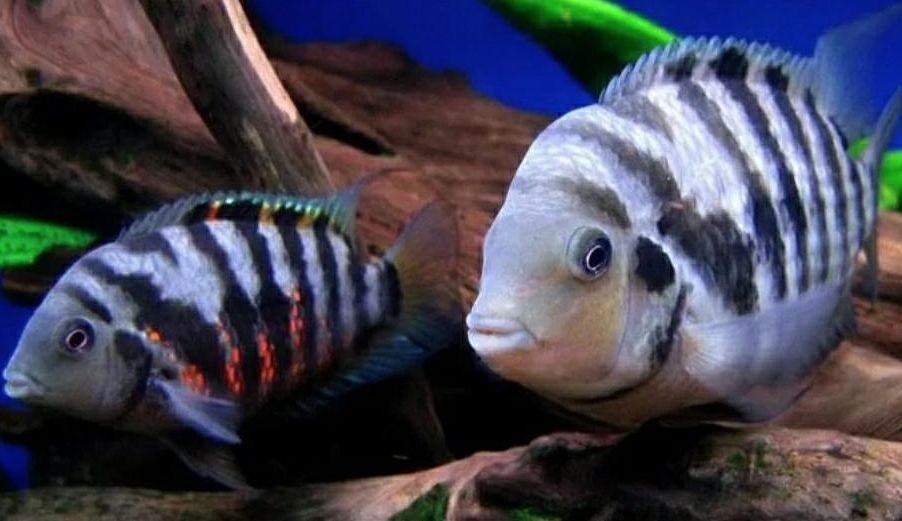
Breeding
It has a very interesting feature – how the Convict cichlid couple takes care of its juveniles, a process which is rather exciting to observe. However, you should keep in mind that this species is very aggressive towards its tank mates. That’s why in the case of small capacity tanks, the couple has to be kept on its own in a tank.
Starting from the age of 3-4 months, they form stable couples. Each couple tends to have its own territory. For this reason, you shouldn’t put more than one couple in a small tank. Otherwise, long and numerous fights for the territory will lead to bad consequences.
For successful breeding, all you need is a male and female fish, but if spawning happens in a community tank – it’s trouble for all its inhabitants. The convict cichlid is monogamous, and it becomes reproductive at the age of 7-10 months. When being just juveniles, create stable couples. If you want such a couple to be created in a tank, you need to keep a small school of fish with an equal number of male and female fish in it.
Convict cichlid spawning happens all the year round with some small breaks. This concerns both separate spawning tanks and community tanks. To get good and healthy juveniles still, it’s better to put them into a separate volume.
Chemical parameters of tank water don’t play an important part. To stimulate the fish spawning, raise the tank water temperature to 29 °C (84 °F) and renew ¼ of tank water with the fresh one.
The male convict cichlid courtship process takes a rather long time. Once it’s finished, the female fish lays the eggs in some place she likes. This can be some flower pot, flat stone, coconut shell, or a big seashell. Or sometimes it may be a big leave of a tank plant. When a spawn is in some nookery, its parents may show aggression to all trespassers (if spawning happened in a community tank). Just like all other cichlid species, this fish eagerly takes care of its breed, taking dead and unfertilized eggs from the nest from time to time.
Once larvae hatch from the eggs, their attentive parents take them to some other place. 2-3 days later, when the larvae have eaten their yolk sac already, they start swimming around the tank carefully guarded by their parents.
The female convict cichlid fish will wave with its fins to get the mud up from the tank substrate to help their juveniles to feed. She raises the food fallen on the bottom and mills it in her mouth, and then spills it out. The breeders surrounded by tiny juveniles carefully swim in the tank with their offspring. By the end of the day, all juveniles get together in their nookery.
As a rule, we don’t take the fish parents from the tank. However, there are cases when males become aggressive, and they may eat all the juveniles. To avoid this, male fish is taken back to the community tank, and the female fish stays to look after their juveniles.
Adult species become caring parents for their offspring for a long time. If you remove the juveniles from the tank too early, the breeders may fight, and as a result, usually, the female suffers. After some time, they start to get on well, and several weeks later, they already have a new offspring.
You should install filtration and aeration in a tank with fry, and you should renew the water about twice a week. Start feed for the fry is any milled live and dry feed. The juveniles are quite large, and they grow very fast. At the age of four months, they obtain adult coloring.